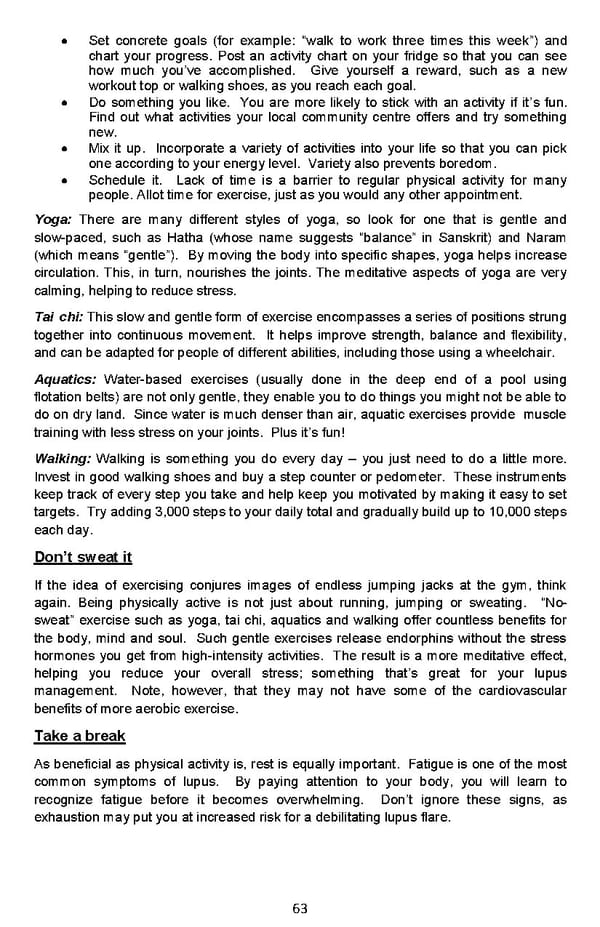• Set concrete goals (for example: “walk to work three times this week”) and chart your progress. Post an activity chart on your fridge so that you can see how much you’ve accomplished. Give yourself a reward, such as a new workout top or walking shoes, as you reach each goal. • Do something you like. You are more likely to stick with an activity if it’s fun. Find out what activities your local community centre offers and try something new. • Mix it up. Incorporate a variety of activities into your life so that you can pick one according to your energy level. Variety also prevents boredom. • Schedule it. Lack of time is a barrier to regular physical activity for many people. Allot time for exercise, just as you would any other appointment. Yoga: There are many different styles of yoga, so look for one that is gentle and slow-paced, such as Hatha (whose name suggests “balance” in Sanskrit) and Naram (which means “gentle”). By moving the body into specific shapes, yoga helps increase circulation. This, in turn, nourishes the joints. The meditative aspects of yoga are very calming, helping to reduce stress. Tai chi: This slow and gentle form of exercise encompasses a series of positions strung together into continuous movement. It helps improve strength, balance and flexibility, and can be adapted for people of different abilities, including those using a wheelchair. Aquatics: Water-based exercises (usually done in the deep end of a pool using flotation belts) are not only gentle, they enable you to do things you might not be able to do on dry land. Since water is much denser than air, aquatic exercises provide muscle training with less stress on your joints. Plus it’s fun! Walking: Walking is something you do every day – you just need to do a little more. Invest in good walking shoes and buy a step counter or pedometer. These instruments keep track of every step you take and help keep you motivated by making it easy to set targets. Try adding 3,000 steps to your daily total and gradually build up to 10,000 steps each day. Don’t sweat it If the idea of exercising conjures images of endless jumping jacks at the gym, think again. Being physically active is not just about running, jumping or sweating. “No- sweat” exercise such as yoga, tai chi, aquatics and walking offer countless benefits for the body, mind and soul. Such gentle exercises release endorphins without the stress hormones you get from high-intensity activities. The result is a more meditative effect, helping you reduce your overall stress; something that’s great for your lupus management. Note, however, that they may not have some of the cardiovascular benefits of more aerobic exercise. Take a break As beneficial as physical activity is, rest is equally important. Fatigue is one of the most common symptoms of lupus. By paying attention to your body, you will learn to recognize fatigue before it becomes overwhelming. Don’t ignore these signs, as exhaustion may put you at increased risk for a debilitating lupus flare. 63
 Living Well With Lupus Facts Booklet Page 62 Page 64
Living Well With Lupus Facts Booklet Page 62 Page 64